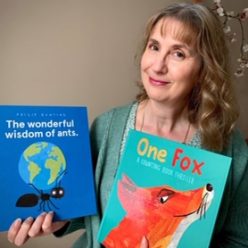Illustrated by Jane Massey

Published by Little Hare Books, Hardie Grant Children’s Publishing, 2021
We live in houses full of stuff but when we go away for holidays, we take just a suitcase or two crammed with the essentials for pared down living. When we are small, we live in a world full of language, sentences, and expressions but we manage to communicate just the same with only a handful of words in our repertoire. Often our first utterances are mumma, dadda, no, mine and more. So, it’s wonderful to see these essential words in a picture book, being used in different situations, with various intonations and meanings, but absolutely understood by parent and child.
Mumma, dadda, no, mine and more are repeated on almost every page, beginning at the start of a typical day in the life of a family and ending at bedtime. The illustrations show us all that is familiar, mum combing her hair, dad brushing his teeth, baby refusing to put clothes, and wanting more toast for breakfast. Cleverly observed moments in a day of the life of a toddler reveal all the times when those five words need to be spoken, sometimes to confirm that the parents are present, other times to refuse to cooperate, and sometimes to insist on ownership!
Very young children will be able to engage with the text and pictures, and perhaps see themselves in some of the situations: not wanting to get in the bath and then not wanting to get out, not wanting to go up the playground slide but choosing the swing instead, tired for bed and wanting one last hug from mum and dad.
I can highly recommend this picture book for children 1-3 years and below I have suggested more picture books which use few or no words to tell a story. Wordless picture books are wonderful for increasing vocabulary, starting discussions, developing comprehension, asking questions, and telling the story differently each time you read it, here are some of my favourites:








by Peggy Rathmann

by Nancy Tafuri



by Marla Frazee

by Jerry Pinkney



by Anne-Margot Ramstein Illustrated by Matthias Aregui

by Amy Krouse Rosenthal Illustrated by Gracia Lam

by Beatrice Rodriguez




by JonArno Lawson
Illustrated by Sydney Smith

by Stephanie Graegin











































































































